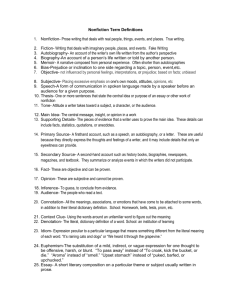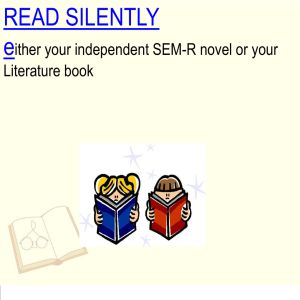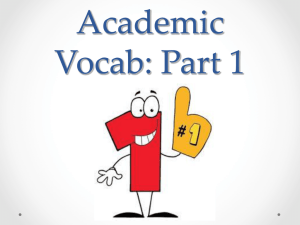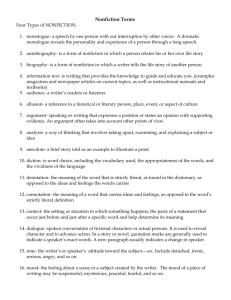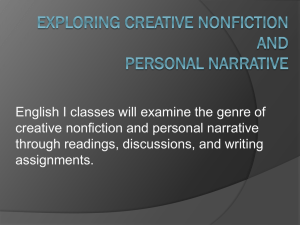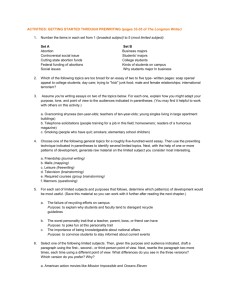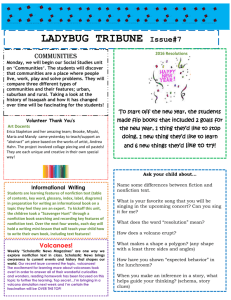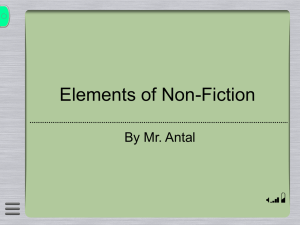MEANING IN NONFICTION
advertisement
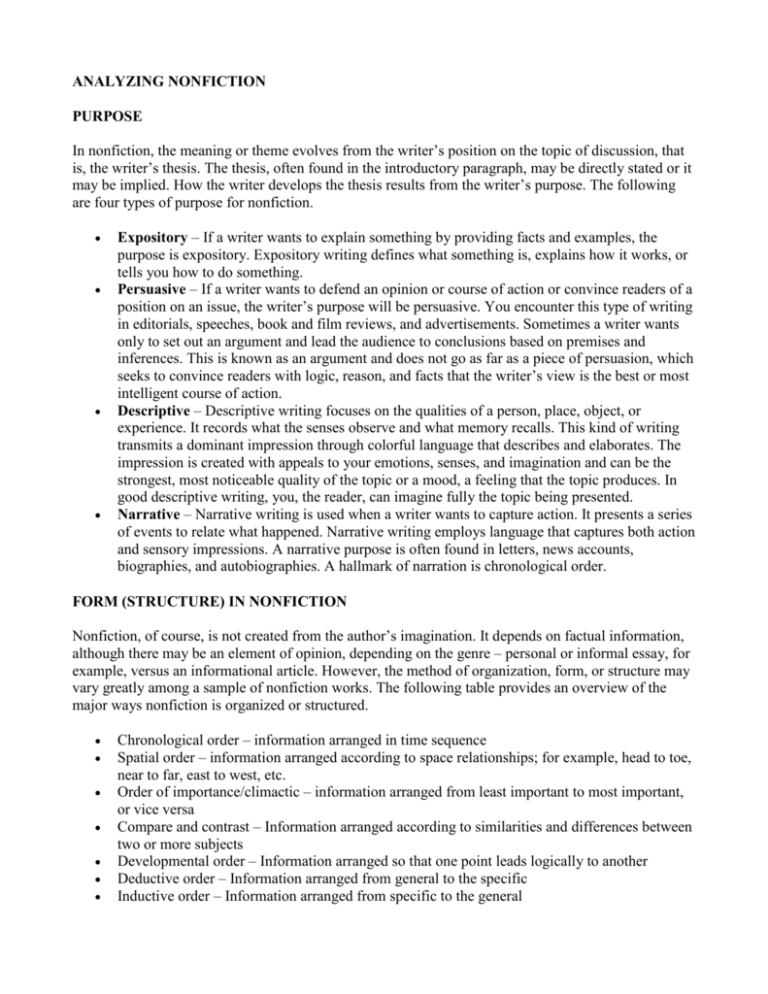
ANALYZING NONFICTION PURPOSE In nonfiction, the meaning or theme evolves from the writer’s position on the topic of discussion, that is, the writer’s thesis. The thesis, often found in the introductory paragraph, may be directly stated or it may be implied. How the writer develops the thesis results from the writer’s purpose. The following are four types of purpose for nonfiction. Expository – If a writer wants to explain something by providing facts and examples, the purpose is expository. Expository writing defines what something is, explains how it works, or tells you how to do something. Persuasive – If a writer wants to defend an opinion or course of action or convince readers of a position on an issue, the writer’s purpose will be persuasive. You encounter this type of writing in editorials, speeches, book and film reviews, and advertisements. Sometimes a writer wants only to set out an argument and lead the audience to conclusions based on premises and inferences. This is known as an argument and does not go as far as a piece of persuasion, which seeks to convince readers with logic, reason, and facts that the writer’s view is the best or most intelligent course of action. Descriptive – Descriptive writing focuses on the qualities of a person, place, object, or experience. It records what the senses observe and what memory recalls. This kind of writing transmits a dominant impression through colorful language that describes and elaborates. The impression is created with appeals to your emotions, senses, and imagination and can be the strongest, most noticeable quality of the topic or a mood, a feeling that the topic produces. In good descriptive writing, you, the reader, can imagine fully the topic being presented. Narrative – Narrative writing is used when a writer wants to capture action. It presents a series of events to relate what happened. Narrative writing employs language that captures both action and sensory impressions. A narrative purpose is often found in letters, news accounts, biographies, and autobiographies. A hallmark of narration is chronological order. FORM (STRUCTURE) IN NONFICTION Nonfiction, of course, is not created from the author’s imagination. It depends on factual information, although there may be an element of opinion, depending on the genre – personal or informal essay, for example, versus an informational article. However, the method of organization, form, or structure may vary greatly among a sample of nonfiction works. The following table provides an overview of the major ways nonfiction is organized or structured. Chronological order – information arranged in time sequence Spatial order – information arranged according to space relationships; for example, head to toe, near to far, east to west, etc. Order of importance/climactic – information arranged from least important to most important, or vice versa Compare and contrast – Information arranged according to similarities and differences between two or more subjects Developmental order – Information arranged so that one point leads logically to another Deductive order – Information arranged from general to the specific Inductive order – Information arranged from specific to the general TONE – Tone refers to the methods and techniques that writers use to reveal attitudes and is found in both fiction and nonfiction. You can also consider tone the mood of a work and the devices used to create that mood. A work may have a tone that is formal, informal, solemn, humorous, serious, condescending, or ironic, among others. Authors convey tone with their style, elements such as word choice, sentence structure, and details. In addition, you can determine tone by recognizing the writer’s intent and analyzing the writer’s comments. The feeling a story leaves you with is an excellent indicator of tone. (Other possible tones might include admiration, anger, apathy, approval, contempt, disappointment, doubt, hostility, indifference, optimism, pessimism, pride, rage, regret, reflection, respect, surprise, and sympathy.) TONE IN WORKS OF NONFICTION In nonfiction, tone results from the purpose of the work. The chart below lists tones that are characteristic of each type of nonfiction. Type.................. Tone Expository.......... Informative Persuasive.......... Reasoned, convincing Descriptive..........Informative, entertaining; eliciting a specific mood, such as exhilaration, gloom, or amazement Narrative:............Any tone appropriate to the genre and purpose; for example, an autobiography may be humorous, witty, and urbane; a biography may be tragic, ironic, or amusing To determine the tone of a nonfiction work, first decide upon the author’s purpose. Using that purpose, determine the tone appropriate for the type of writing. Use the questions suggested above for fiction to reveal the tone for narrative and descriptive writing. WHAT MAKES IT GOOD NON-FICTION? Interesting – it holds the reader’s interest Intriguing – it creates and/or satisfies one’s curiosity about the topic or person Insightful – it has a unique perspective that makes us think more deeply about the topic Entertaining – it affects our emotions (laugh, cry, scare, etc.) Educational – it teaches us something that we didn’t know before Inspiring – (debatable as to its contribution) – it makes us want to take action
